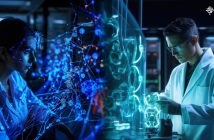Paul Matthews, freelance tech writer, writes about examples of machine learning across the the healthcare, entertainment, marketing and education industries.
From front end development to the automotive sector, the applications of machine learning for business purposes is bigger than ever. Examples of machine learning in the real world include recommendation engines, object detection, natural language processing, and more. Let’s analyse five interesting examples of how ML is being used to deliver better online experiences and advance healthcare and education.
1. Music: Spotify and Soundcloud
Companies like Universal, Sony and EMI have gone through a massive digitalization in the past 10 years, evolving from “selling a certain number of records” to “streaming that record for ‘n’ number of times”. Monetization via ads through plays on portals like Youtube, Spotify and Soundcloud is something sought after. How can these platforms constantly drive traffic and ears towards their releases in such a noisy music marketplace? By automatically attracting more and more users, with Machine Learning tools. How many times you’ve seen (or better, heard) a random track in your daily mix advised as “something based on your tastes’? The answer to this very matter is a relatively simple application which combines
1. the actual song’s structure, and
2. the fact that users have played your song of choice before or after the recommended one.
Both Spotify and Soundcloud use ML algorithm to understand and analyze the user’s choices and make a decision based on the info they’ve gathered.

2. PathAi: Quick Diagnosis with Tensorflow
PathAi is mainly aTensorflow based application which helps in speeding up diagnosis by associating symptoms and other environmental variables (demographic, location and such). PathAI’s biggest selling point is the fact that not only it could be launched on a completely cloud-based architecture, but it is also extremely slim, compared to other bulky pieces of software in the healthcare sector, which are, sometimes, requiring ad-hoc hardware. PathAi is definitely set to become extremely big in the nearest future, given its recent wave of investment which amounted for over $11 million.
It is quite hard to list any ML or tech-related medical startup as a future “industry standard” but, for now, we can safely say that PathAi is setting the foundation in regards to the future of health and technology.
3. Concerto: Medical Data Science Via ML
With Concerto, we’re still analysing the healthcare sector and its machine learning-based applications. When Concerto was developed, their creators had a clear idea: building something which could have helped oncologists, surgeons and general doctors in understanding symptoms, by automatically processing bulky, sometimes confusing databases within a fraction of second. Concerto is, in fact, the first data science-related tool for medical purposes. Built in New York by a team of former data scientists, Concerto has been a refreshing scent of technology in a medical world which, in terms of data processing, still relies on paper and slow communication between professionals, making, sometimes, the development of any form of procedure slow and stressful. Concerto is a strong, tangible example of how data science applies to infrastructures and architectures for building processes and not for mere marketing goals and retargeting ads. Concerto is set to become the most used database in 2025, at least in the states.
4. Web Personalization: What You Like, When You Want It
Ah, machine learning and marketing. If this isn’t the biggest combination of the decade, then there isn’t another one. With web personalization, we refer to the usage of a number of programming languages (mainly Python and Javascript) to optimise a catalogue, a product listing, or a piece of content on a web page/application. The personalization process is divided into 3 main sections, acquisition, processing and build.
-The acquisition part refers to data gathering which is done when a user lands on a page (mainly via cookies, therefore), answers a survey via email, or types anything on the page’s search box. This part must be clarified to the user following GDPR’s latest ruling.
-The processing part is related to the usage of Python libraries which are, indeed, processing users’ behaviours, creating data points in an internal data lake environment, which effectively become guidelines for Javascript tools which are rendering this data in customised content.
-The build process is the one which happens when the above-mentioned Javascript tool optimises the page. If, for example, the guidelines within those data points are saying that the user x, who likes red shoes, is currently browsing the footwear section, the JS-based application will move such results on top, increasing, therefore, the site’s conversion rate. Very simple, yet very effective.
Personalization is being used by several brands including Zara, Primark, Boohoo and ASOS.
5. Education As a Whole
There are dozens of education-related startups which are building machine learning-based tools to improve this educational sector. What is their goal? Here are some examples of machine learning uses in education:
– Problem solving and getting accurate data easily. Imagine having a teacher who can access complicated problems in a matter of seconds, to then explain them in the simplest form after the software has shrunk them down, depending on the audience’s level.
– Automatically creating tasks and exams based on the topic, its level of difficulty and more. Pretty life saving for a teacher, right? An ML algorithm for this could be trained to put out an exam paper with the required level of difficulty and could also have the solutions automatically calculated.
– Analyzing and predicting the class’s progress, by analysing the success rate of exams and essays, will help teachers in evaluating themselves as well
Conclusion
The examples of machine learning in today’s world are endless. It’s easy to understand why the future of ML is so bright, both from a business perspective as well as user perspective. The future is, indeed, automated.
Need to consult a machine learning expert? Hire freelance scientists on Kolabtree. It’s free to post your project and get started.
Paul Matthews is a Manchester-based business and tech writer who writes in order to
better inform business owners on how to run a successful business. He’s currently
consulting the biggest team of app developers in Manchester.







